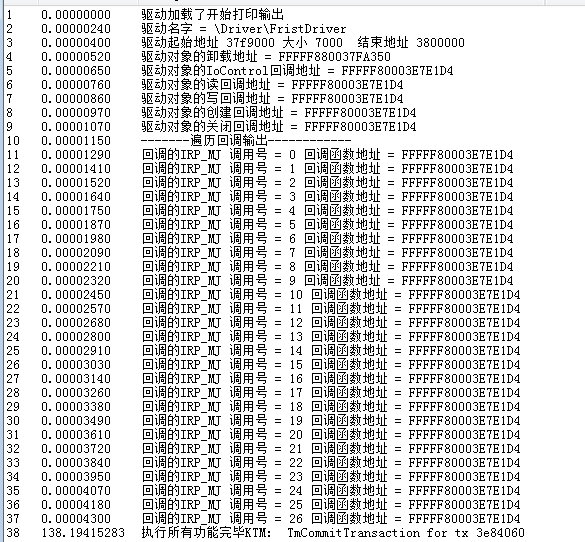这篇文章主要讲解了“什么是内核驱动对象”,文中的讲解内容简单清晰,易于学习与理解,下面请大家跟着小编的思路慢慢深入,一起来研究和学习“什么是内核驱动对象”吧!
驱动对象讲解
1.1 结构
1.2 输出代码输出基本的驱动对象信息
1.3 结果
在内核中. 每一个驱动模块都是一个驱动对象. 都有一个 DRIVER_OBJECT结构体代表. 可以想象成驱动对象是一个进程容器. 容纳百川.
下面针对驱动对象做一下简单的成员输出.以熟悉驱动对象.
驱动对象结构如下:
typedef struct _DRIVER_OBJECT {CSHORT Type;CSHORT Size;//// The following links all of the devices created by a single driver// together on a list, and the Flags word provides an extensible flag// location for driver objects.//PDEVICE_OBJECT DeviceObject;ULONG Flags;//// The following section describes where the driver is loaded. The count// field is used to count the number of times the driver has had its// registered reinitialization routine invoked.//PVOID DriverStart; //驱动对象的起始地址ULONG DriverSize; //驱动对象的大小PVOID DriverSection; //驱动对象结构.可以解析为_LDR_DATA_TABLE_ENTRY 是一个链表存储着下一个驱动对象 PDRIVER_EXTENSION DriverExtension; //驱动的扩展信息.可以自定义存放我们的数据 //// The driver name field is used by the error log thread// determine the name of the driver that an I/O request is/was bound.//UNICODE_STRING DriverName; //驱动对象的名字//// The following section is for registry support. This is a pointer// to the path to the hardware information in the registry//PUNICODE_STRING HardwareDatabase;//// The following section contains the optional pointer to an array of// alternate entry points to a driver for "fast I/O" support. Fast I/O// is performed by invoking the driver routine directly with separate// parameters, rather than using the standard IRP call mechanism. Note// that these functions may only be used for synchronous I/O, and when// the file is cached.//PFAST_IO_DISPATCH FastIoDispatch;PDRIVER_INITIALIZE DriverInit;PDRIVER_STARTIO DriverStartIo;PDRIVER_UNLOAD DriverUnload; //驱动对象的卸载地址PDRIVER_DISPATCH MajorFunction[IRP_MJ_MAXIMUM_FUNCTION + 1];
} DRIVER_OBJECT;typedef struct _DRIVER_OBJECT *PDRIVER_OBJECT;#include <ntddk.h>
VOID MyDriverUnLoad(
_In_ struct _DRIVER_OBJECT* DriverObject
)
{
DbgPrint("驱动卸载了\r\n");
}extern "C" NTSTATUS DriverEntry(
_In_ PDRIVER_OBJECT DriverObject,
_In_ PUNICODE_STRING RegistryPath
){
ULONG64 uImage = 0;
DriverObject->DriverUnload = MyDriverUnLoad;
DbgPrint("驱动加载了开始打印输出\r\n");
DbgPrint("驱动名字 = %wZ \r\n", DriverObject->DriverName);
DbgPrint("驱动起始地址 %x 大小 %x 结束地址 %x\r\n",
DriverObject->DriverStart,
DriverObject->DriverSize,
uImage = ((ULONG64)DriverObject->DriverStart + DriverObject->DriverSize));
DbgPrint("驱动对象的卸载地址 = %p\r\n", DriverObject->DriverUnload); //输出驱动对象的所有回调地址.
DbgPrint("驱动对象的IoControl回调地址 = %p\r\n", DriverObject->MajorFunction[IRP_MJ_DEVICE_CONTROL]);
DbgPrint("驱动对象的读回调地址 = %p\r\n",DriverObject->MajorFunction[IRP_MJ_READ]);
DbgPrint("驱动对象的写回调地址 = %p\r\n",DriverObject->MajorFunction[IRP_MJ_WRITE]);
DbgPrint("驱动对象的创建回调地址 = %p\r\n",DriverObject->MajorFunction[IRP_MJ_CREATE]);
DbgPrint("驱动对象的关闭回调地址 = %p\r\n",DriverObject->MajorFunction[IRP_MJ_CLOSE]);
DbgPrint("-------遍历回调输出------------\r\n"); //宏从DrverObject对象中查找for (auto i = 0; i < IRP_MJ_MAXIMUM_FUNCTION; i++)
{
DbgPrint("回调的IRP_MJ 调用号 = %d 回调函数地址 = %p \r\n", i, DriverObject->MajorFunction[i]);
}
DbgPrint("执行所有功能完毕"); return STATUS_SUCCESS;
}
感谢各位的阅读,以上就是“什么是内核驱动对象”的内容了,经过本文的学习后,相信大家对什么是内核驱动对象这一问题有了更深刻的体会,具体使用情况还需要大家实践验证。这里是亿速云,小编将为大家推送更多相关知识点的文章,欢迎关注!
免责声明:本站发布的内容(图片、视频和文字)以原创、转载和分享为主,文章观点不代表本网站立场,如果涉及侵权请联系站长邮箱:is@yisu.com进行举报,并提供相关证据,一经查实,将立刻删除涉嫌侵权内容。